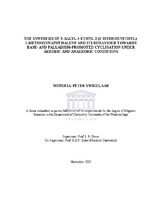| dc.description.abstract | Over the years, Giles and co-workers have established that, upon treatment with potassium tert-butoxide, tetra-substituted naphthalenes undergo cyclisations to afford naphthopyrans. It was suggested that these base-induced cyclisations was as a result of the reacting centers being forced into close proximity as a consequence of steric crowding. This thesis describes the synthesis of 3-allyl-4-ethyl-2-(1′-hydroxyethyl)-1-methoxy-naphthalene 177 and its behaviour towards Pd(0) and potassium tert-butoxide under aerobic and anaerobic conditions, to verify whether the base-promoted cyclisations are indeed caused by the steric influences of the substituents. Two synthetic routes were attempted in the synthesis of the target naphthalene 177. The first of these attempted routes involved the conversion of 2-acetyl-4-hydroxy-1-methoxynaphthalene 182 into 2-acetyl-1-methoxy-4-trifluoromethanesulphonyloxy-naphthalene 191 and subsequently into 2-acetyl-4-ethyl-1-methoxynaphthalene 192 via Stille coupling. However, the subsequent Snieckus ortho-directed metalation reactions on the reduced 4-ethyl-2-(1′-hydroxyethyl)-1-methoxynaphthalene 193, and analogues of it, to afford naphthalene 177 were unsuccessful. The second route entailed a Claisen rearrangement of the tri-substituted 2-acetyl-4-allyloxy-1-methoxynaphthalene 209 to afford the unstable tetra-substituted 2-acetyl-3-allyl-4-hydroxy-1-methoxynaphthalene 210, which was immediately converted into the corresponding 2-acetyl-3-allyl-1-methoxy trifluoromethanesulpholnyloxynaphthalene 211. Stille coupling of the triflate 211 gave the 2-acetyl-3-allyl-4-ethyl-1-methoxy-naphthalene 212, which was subsequently reduced to the target naphthalene alcohol 177.The base-induced cyclisation studies performed on naphthalene 177, confirmed the hypothesis that these cyclisations of terta-substituted naphthalenes are indeed as a result of steric crowding. | en_US |

